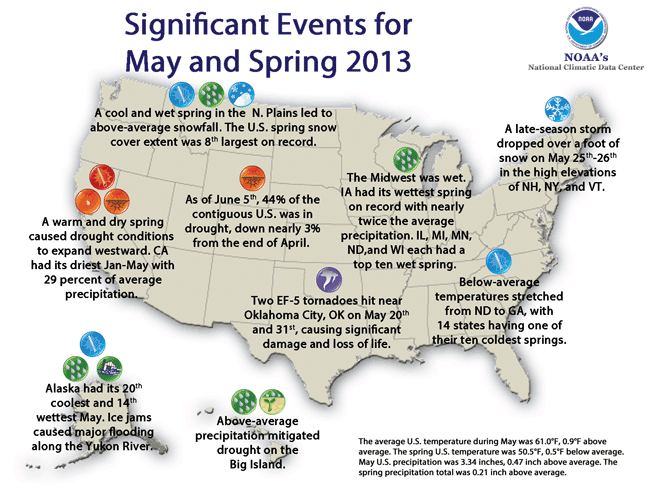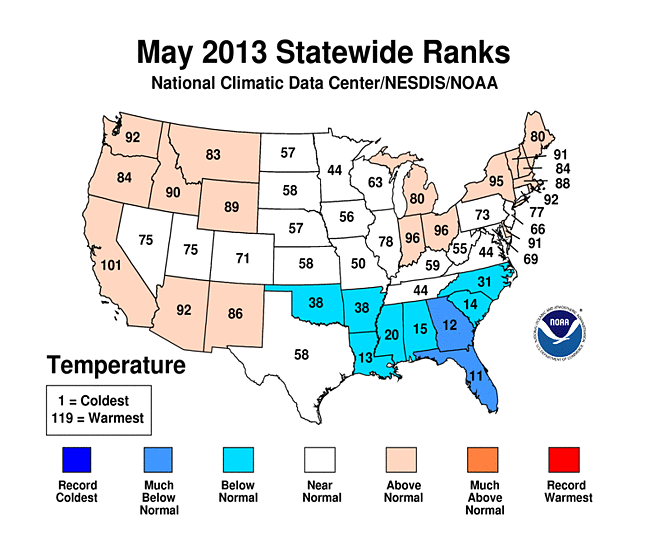Monthly Report Summary Information
The Monthly Report Summary Information is a synopsis of the collection of national and global summaries released each month.
National Summary Information - May 2013
See Full Report
Contiguous U.S. cooler and slightly wetter than average during spring
Spring temperatures coolest since 1996 despite May being warmer than average. Nation experiences floods in the Midwest, two EF-5 tornadoes in the Plains, and drought expansion in the West.
The average temperature for the contiguous U.S. during the spring season (March-May) was 50.5°F, 0.5°F below the 20th century average, making it the 38th coolest spring on record. The May temperature for the contiguous U.S. was 61.0°F, 0.9°F above the 20th century average and the 40th warmest May on record.
The total spring precipitation averaged across the contiguous U.S. was 7.92 inches, 0.21 inch above the 20th century average. May contributed 3.34 inches of rain to the spring precipitation total, and was the 17th wettest May on record. Drought conditions continued to improve for parts of the Plains, but worsened in the West.

Significant climate events for May and Spring 2013.
Click image to enlarge, or click here for the National Overview.
Note: The May Monthly Climate Report for the United States has several pages of supplemental information and data regarding some of the weather/climate events from the month and spring season.
U.S. climate highlights: May
- The southeastern U.S. was cooler than average, while the rest of the nation had near and above-average May temperatures. Florida had its 11th coolest May, and Georgia had its 12th coolest, with monthly temperatures 1.5°F and 2.6°F below average, respectively.
- Most of the northern U.S. had above-average May precipitation. Iowa had its wettest May on record with 8.84 inches of precipitation, 4.77 inches above average. Montana and North Dakota each had one of their ten wettest Mays. The above-average precipitation contributed to flooding along several major rivers in the region including the Mississippi River and the Illinois River.
- Alaska was cooler and wetter than average during May. The statewide temperature was 5.8°F below the 1971-2000 average, the 20th coolest May on record. The statewide precipitation total was 25.1 percent above average, making it the 14th wettest May.
- According to the June 4 U.S. Drought Monitor Report, 44.1 percent of the contiguous U.S. was experiencing moderate-to-exceptional drought, smaller than the 46.9 percent at the beginning of May. Drought continued to improve for parts of the Great Plains, but worsened in the West. Several months of warm and dry conditions in California led to nearly the entire state being in drought by early June.
- Despite a below-average preliminary tornado count during May for the contiguous U.S., several large and powerful tornadoes hit populated areas resulting in significant damage and loss of life. Two EF-5 tornadoes, the highest strength rating given to a tornado, were confirmed near Oklahoma City. The EF-5 tornado that hit Moore, Oklahoma, on May 20th destroyed thousands of homes and businesses in and around the city and was blamed for over 20 fatalities. According to preliminary analysis, the EF-5 near El Reno, Oklahoma, on May 31st had a path width of approximately 2.6 miles, the widest tornado ever observed in the United States. These two events were only the 7th and 8th EF-5 tornadoes confirmed in Oklahoma in the 64-year period of record.
- Spring was cooler than average for a large portion of the contiguous United States east of the Rockies. Fourteen states, from North Dakota to Georgia, had spring temperatures that ranked among the ten coldest.
- This was the first season since Spring 2011 not classified as "warmer than normal", or in the warmest one-third of the historical distribution.
- New England and the West were both warmer than average. California had its seventh warmest spring on record with a seasonal temperature 3.5°F above average.
- Spring brought both wet and dry precipitation extremes to the United States. Iowa had its wettest spring on record with 17.61 inches of precipitation, 8.63 inches above the seasonal average. Wetter-than-average conditions were observed in the Northern Plains and Midwest, where North Dakota, Minnesota, Wisconsin, Illinois, and Michigan each had one of their ten wettest spring seasons.
- Below-average precipitation was observed in the Mid-Atlantic, Southern Plains, and West. New Mexico had its second driest spring with 0.66 inch of precipitation, 1.72 inches below average. California had its eighth driest spring, with 2.34 inches of precipitation, 3.33 inches below average.
- The above-average precipitation and below-average temperatures in the north-central United States were associated with a spring snow cover extent that was above average. According to data from the Rutgers Global Snow Lab, the spring snow cover extent was the eighth largest on record and the largest since 1984.
- The U.S. Climate Extremes Index (USCEI), an index that tracks the highest and lowest 10 percent of extremes in temperature, precipitation and drought across the contiguous U.S., was 1.4 times its average during spring. The above-average USCEI was driven by extremes in below-average temperatures, extremes in 1-day precipitation totals, and the spatial extent of drought.
- The year-to-date national temperature of 43.6°F was 0.2°F above the 20th century average. Below-average temperatures were observed for much of the central United States, from the Rockies to the Mid-Atlantic. The Northeast and parts of the West had above-average year-to-date temperatures.
- The January-May precipitation total for the contiguous U.S. was 12.28 inches, 0.33 inch above average. North Dakota, Minnesota, Wisconsin, Missouri, and Mississippi each had a top ten wet 5-month period; Iowa, Illinois, and Michigan were record wet during January-May.
- The West, Southern Plains, and Northeast were drier than average. Oregon, Nevada, and Idaho each had a top ten dry year-to-date period, while California had its driest January-May on record with 4.09 inches of precipitation, 9.87 inches below average.
 NOAA's National Centers for Environmental Information
NOAA's National Centers for Environmental Information

